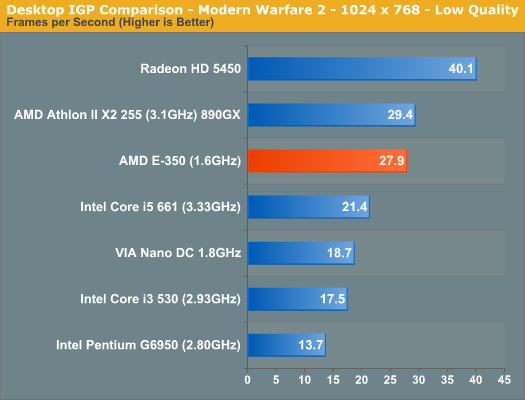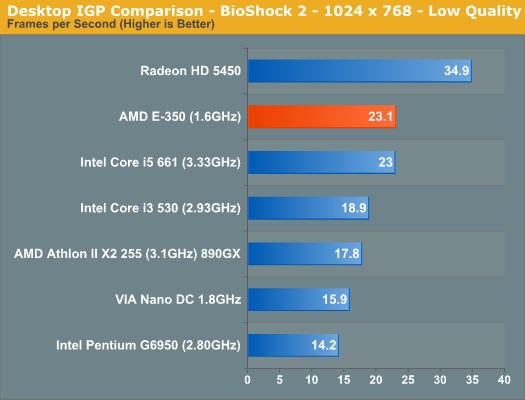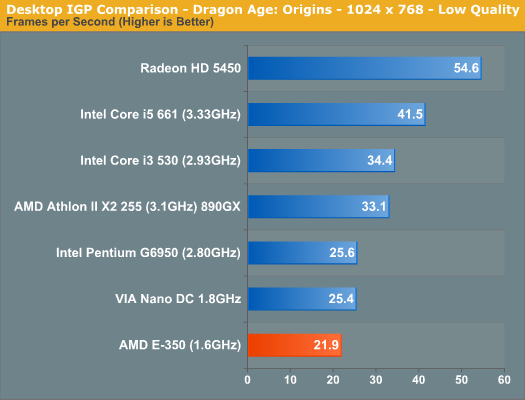The Brazos Performance Preview: AMD E-350 Benchmarked
by Anand Lal Shimpi on November 16, 2010 12:01 AM ESTDesktop IGP Comparison: Faster than Clarkdale
I split the graphics comparison into two sections: desktop and mobile. For the desktop section I compared the E-350 to the latest Clarkdale chips, AMD's own 890GX and a discrete Radeon HD 5450 graphics card. While the Radeon HD 5450 has the same number of shader processors as the E-350 (80), they run faster and it has a dedicated 1.6GHz memory bus to feed it. The E-350 has to share memory bandwidth between the two Bobcat cores and the 80 SPs, severely limiting its performance potential.


The E-350 does extremely well compared to its desktop brethren. In our Modern Warfare 2 and BioShock tests its easily faster than the Core i3/i5 and in the case of BioShock 2 it's even faster than AMD's 890GX. Dragon Age Origins is another story however as the benchmark is primarily CPU limited, giving the desktop parts a huge advantage. In GPU bound scenarios, it's clear that our initial Zacate benchmarking was accurate: the E-350's Radeon HD 6310 is quicker than Intel's HD Graphics.
Compared to the Radeon HD 5450 the 6310 offers between 66 - 69% of its performance in our GPU bound tests. The performance reduction is entirely due to the 6310's limited memory bandwidth being shared with the dual Bobcat cores on-die.











207 Comments
View All Comments
ET - Tuesday, November 16, 2010 - link
I'm not saying it's a bad product, and as I said it should draw the OEM's. What it doesn't do is change the kind of products available. It's not significantly faster, doesn't really allow gaming, it's just another entry point that's not bad. It will power yet another bunch of low cost notebooks that can only be used for everyday tasks. At the netbook side it may be a little more convincing, since it saves the need for an extra chip for video, and benchmarks showed a significantly higher javascript speed compared to an Atom, which matters. But still, there's no wow factor about it.As a consumer I will certainly prefer an AMD netbook with this chip to an Atom based one, it's just that I was hoping for more. From my point of view, the advantage of such a netbook over Atom+Ion:
- Lower price
- Perhaps smoother everyday use (hinted at by the javascript benchmark)
- No artificial hardware limits, far as I know, so I expect to see a "netbook" with 4GB of RAM (or at least upgradeable to that)
- If I'd want to try Direct3D development on it (which I did in the past on similar strength hardware), I'll have the full DX11 feature set, even if at very low speed.
flyck - Tuesday, November 16, 2010 - link
it IS significantly faster. What the benchmarks do not show is single threaded applications. Single threaded is dead slow on Atom. e.g. starting an application/user interfaces all single threaded will feel slugish on Atom and not on Ontario.1Ghz Bobcat equals around 1.6GHz Atom cpu in single threaded applications how is that disappointing for a smaller cpu?
ET - Tuesday, November 16, 2010 - link
> 1Ghz Bobcat equals around 1.6GHz Atom cpu in single threaded applications how is that disappointing for a smaller cpu?Because as a consumer I don't care at all whether the CPU is smaller. I care about performance (and I do care to an extent about characteristics like power consumption and heat, but that's a lesser factor). Being given another CPU which performs like an Atom is disappointing. I didn't want another Atom. I was hoping that AMD for once will be able to take the performance crown, and by a significant margin, and I'm disappointed that it couldn't.
AMDJunkie - Tuesday, November 16, 2010 - link
Also, it should play Crysis. And be $100 cheaper. And use sub-1W power. You know what, knock another $100 off that price. Why isn't it free?Sometimes, I think the big corporations are just holding back, trying to squeeze a buck out of us enthusiasts. There's no difficulty at all making a chip that does everything at this price range, they just don't want to. :(
flibbertigibbet - Tuesday, November 16, 2010 - link
I am very disappointed by Anand's choice of systems to benchmark Zacate against. He himself says it is intended to compete in the ultra-portable, high end netbook, nettop, and low end notebook space. That being the case, I think some of the following systems would have made for a better comparison:- Atom N550 (with and without Ion2)
- AMD Nile (K325/K625 + Radeon 4250)
- Intel 2009 CULV (Celeron SU2300/Pentium SU4100 + Intel G45/ Nvidia Ion)
- Intel 2010 ULV Arrandale + Intel HD
I'm happy he included the VIA Nano DC. I hope OEM's come up with sleek, portable machines matched with high-capacity batteries to match Zacate. Can't wait to see more detailed power consumption and battery numbers.
Anand Lal Shimpi - Tuesday, November 16, 2010 - link
I focused mainly on making sure we had low end notebook coverage ($400 - $500 notebooks will have a ~2.2GHz Pentium DC or Core i3), however I've been running i3-330UM numbers this morning and just updated the gaming performance charts with them - refresh to see the new comparison :)Take care,
Anand
trivik12 - Tuesday, November 16, 2010 - link
it would be interesting to compare bobcat with oaktrail platform. That supposedly has very good idle power consumption(supposedly in ARM league) and better load power consumption compared to current solutions.I am sure intel will release CULV based on Sandy Bridge if there is big enough competition from bobcat. 18V CULV with SB core will make it interesting for sure.
Anyway I am glad to see bobcat destroying atom as intel had little intention of making Atom a decent chip. Hopefully this will make intel do something different with oaktrail and medfield.
antaholics - Tuesday, November 16, 2010 - link
I hope nobody asked this yet, but I noticed that the i3/i5 ULVs were not benchmarked to compare. They're at a slightly higher price bracket ($500-700+), but not something consumers wouldn't consider if they're in the market for a high-end netbook.Thanks!
antaholics - Tuesday, November 16, 2010 - link
and they have similar battery life/TDP as Brazos and Atom, unlike the pentium DC and i3 testedSandmanWN - Tuesday, November 16, 2010 - link
When you buy anything your first metric is money. You don't just arbitrarily decide to consider a higher price bracket. You wouldn't even consider this if you where looking at the 500-700+ price range.